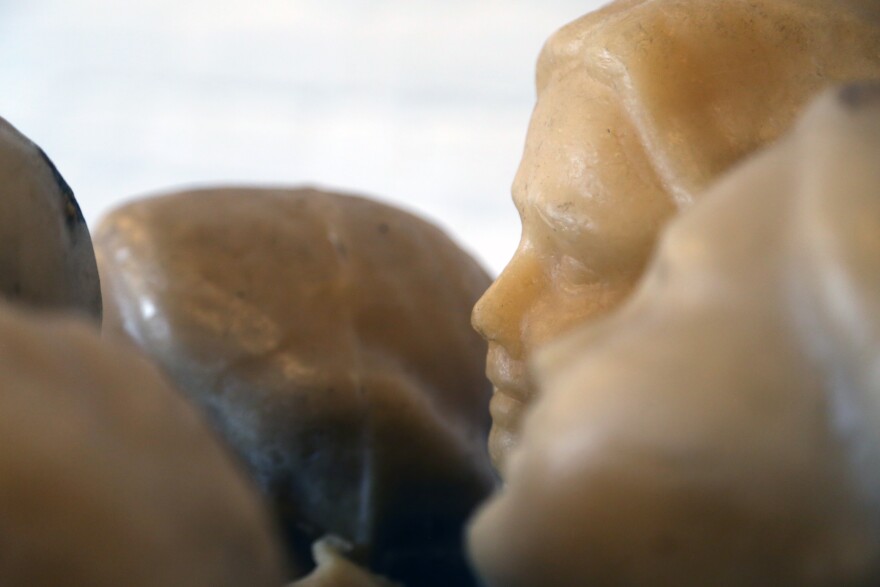Michael Olijnyk has a hard time throwing things away. He’s co-director of the Mattress Factory, along with with Barbara Luderowski. They live in the museum, on an upper floor.
“We are obsessive, obsessive collectors,” he said.
Not hoarders, Olijnyk specified.
“You’re not gonna find us under a tower of New York Times,” he said, with a chuckle.

When it comes to the remnants of past installations and performance art pieces, they’ve kept some odd pieces.
“We thought, 'Hey, these wax heads from Ann Hamilton, aren’t they spectacular? Let’s put them into a box. Can we have your underwear Kim Jones? Because that was part of your Mudman performance,’" Olijnyk said. "And we have them."
Yes, crunchy, mud-caked underwear. They were left over from a performance in 1990 recreating a trek through rice fields in Vietnam.
“It still looks pretty good to me,” said archivist Sarah Hallet, whose job it is to preserve these items.
Her job is in the spotlight this week, as the Mattress Factory Museum celebrates its 40th anniversary. Museum curators are digging out some archived pieces from decades' worth of installations to display at an after-hours event March 16.

Olijnyk said he loves the scale of installation art and its experimental nature.
“It’s really nice to be able to walk into the center of a piece of artwork and not have to think about it,” he said.
This museum is known for its huge pieces, such as a three-story house transformed into one giant string maze. But those installations have their challenges.
“Like where do you get 14,000 pounds of paraffin wax?” he said.

And when the show that used the wax was over, somebody came to get it. Did they use it to make candles? No one is quite sure what happened to it. Usually, Olijnyk said the materials just get trashed. The pieces don’t travel; they’re site specific and built for the room they’re in.
Olijnyk said they didn’t have a vision, they just instinctually started keeping bits and pieces of retired shows.
“So some of these physical things that we’ve kept can describe what’s happened within that 40 year period,” he said. “You’ll never see the piece again, but you’re able to understand it on some level because there’s a physical thing in front of you rather than a video or a photograph.”
The archive itself is upstair, a narrow room filled with large metal cabinets and items stacked up to the ceiling.

One of the first items in front of its cloaked, black door entrance is a stack of books covered in plaster. It's one of more than 200 archived pieces.
“There’s burnt wood in boxes in there,” said Hallett, as she dug through cabinets covered in clear plastic tarps. “We have a foot right there, some hands. Yeah, there’s just so much cool stuff in here.”
As one goes deeper into the archive, things just keep getting weirder.
“We have these heads which were cast out of a mold and then they were paper mached and they were covered in phosphorus and banana pulp, so they’re actively decaying,” Hallett said.
Olijnyk pulled out a scale model of an old installation.

“And look how beautifully it’s categorized. It has a picture of it on the outside of the box,” he said.
He has a deep connection to these pieces and their artists, he said.
“To have a letter from John Cage or drawings that James Turell did on a napkin of a project, it’s just interesting," he said. "And at the beginning, you didn’t think it was so interesting."
And age has certainly added interest to the building itself. It was once a candy factory, distribution center during World War II and, most notably, a Stearns & Foster mattress factory.
When co-director Barbara Luderowski bought it decades ago, the North Side wasn't as popular a destination. But she saw opportunity, she said, and over the years, the museum has become known.

She said it's loved by artists around the world, because it has no limits.
“We basically let anyone do whatever they want to do,” Olijnyk said. “Literally, it’s this beautiful raw warehouse space. If you wanna cut through something, sure, let’s talk about that. If you want to build something in the middle of it, screw directly to the floor, hang it from the ceiling?”
Well, there is at least one limit.
"The Mattress Factory is not going to stop making pieces, not going to stop collecting things. It’s going to keep going, so we’re going to need more room for the archive,” he said.
For now, they’ll just keep piling up the boxes.









